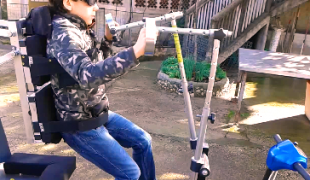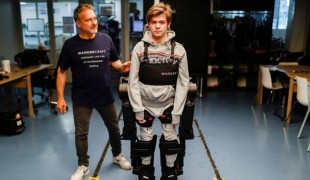- 8989
- 449
- 31
- 24
- 0
- Help Ukraine
About the solution
The invention consists of a block of wood and a kind of cane, allowing to double each step of the staircase of an intermediate step that his wife moves as she ascends.
Mrs. Sondag had a surgery over 20 years ago, and had a fall at the hospital. This left her with a muscle tear, which meant it was hard for her to move. Over the years, it became impossible for her to climb the stairs.
Because the Sondag’s house had stairs, Eugene took action. After thinking about it, he realized that the solution would be to reduce the height of the steps. He therefore thought of adding intermediate steps on the stairs.
"My grandfather was a carpenter. When I was little, I accompanied him. I also helped my dad to restore old furniture. I myself installed our fitted kitchen. I always liked to tinker”, the inventor explained.
So Eugene developed a removable ramp and a cane and now his wife is able to climb the stairs by herself.
"It was a joy for her to be able to climb these five steps again”, Eugene affirmed.
Adapted from: http://bit.ly/2kBA2Wx
This solution shall not include mention to the use of drugs, chemicals or biologicals (including food); invasive devices; offensive, commercial or inherently dangerous content. This solution was not medically validated. Proceed with caution! If you have any doubts, please consult with a health professional.
DISCLAIMER: This story was written by someone who is not the author of the solution, therefore please be advised that, although it was written with the utmost respect for the innovation and the innovator, there can be some incorrect statements. If you find any errors please contact the patient Innovation team via info@patient-innovation.com
-
-
156
-
0
-
2128

Hip & co- a mum's invention for hip dysplasia
CAREGIVING
BODY BALANCE: Maintaining body balance
STANDING UP: Standing up from a seated position
WALKING WITH A WALKING AID: Walking with a walking aid
WALKING: Walking
Hip Dysplasia
Assistive Daily Life Device (to help ADL)
Walking Aid (wheelchair/walker/crutches)
Difficulty walking or moving
Muscle weakness
Limited range of motion
Muscle pain or stiffness
Loss of muscle coordination
Muscle cramps or spasms
Joint deformity
Joint redness or warmth
Swelling or inflammation
Difficulty bearing weight
Numbness or tingling in the extremities
Frequent falls
Joint pain or swelling
Restoring mobility
Managing pain
Promoting self-management
Preserving Organ Function
Recovering from Traumatic Injuries
Maintaining Balance and Mobility
Raise awareness
Caregiving Support
General and Family Medicine
Orthopedics
Pediatrics
Australia
-
-
-
410
-
3
-
6666

I'VE PATENTED A MACHINERY THAT ALLOWS TO PHYSYCALLY IMPAIRED TO WALK :)
WALKING WITH A WALKING AID: Walking with a walking aid
WALKING: Walking
MOVING IN A WHEELCHAIR: Moving using a wheelchair.
Muscular Dystrophy
Muscle Tone Abnormalities
Brain Injury (Abscess, Brain Barrier Defect, Brain Contusion, Brain Hemorrhage, Brain Edema)
Neuromuscular Disorders
Cerebral Palsy
Walking Aid (wheelchair/walker/crutches)
Assistive Daily Life Device (to help ADL)
Difficulty coordinating movements
Stiffness or rigidity (difficulty moving)
Paralysis of the legs and lower body
Muscle weakness
Restoring mobility
Managing Neurological Disorders
Preventing (Vaccination, Protection, Falls, Research/Mapping)
General and Family Medicine
Medical Genetics
Neurology
Orthopedics
Pediatrics
Italy
-
-
-
235
-
0
-
3611

Father creates exoskeleton to help son with genetic neurological condition walk
BODY BALANCE: Maintaining body balance
STANDING UP: Standing up from a seated position
WALKING WITH A WALKING AID: Walking with a walking aid
CAREGIVING
Cervical spinal cord injury/Tetraplegia
Assistive Technology access
Walking Aid (wheelchair/walker/crutches)
Restoring mobility
Managing pain
Promoting self-management
Preserving Organ Function
Managing Neurological Disorders
Recovering from Traumatic Injuries
Maintaining Balance and Mobility
Restoring Blood Circulation
To improve Treatment/Therapy
Preventing (Vaccination, Protection, Falls, Research/Mapping)
Raise awareness
Caregiving Support
General and Family Medicine
Intensive Care Medicine
Neurology
Physical Medicine and Rehabilitation
Sports Medicine
France
-
 en
en